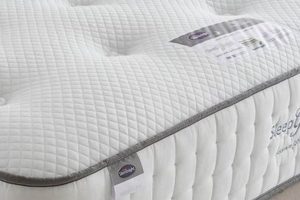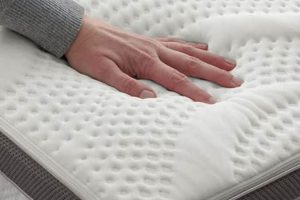The practice of placing a sleep surface directly on the ground, foregoing a bed frame or foundation, represents a minimalist approach to bedding. This configuration involves a mattress resting without elevation, directly on the floor. An example of this setup is a memory foam mattress placed in a bedroom without a box spring or bed frame.
This bedding arrangement can offer certain advantages, including cost savings by eliminating the need for a bed frame and a lower overall bed height, which may be beneficial for individuals with mobility issues or those who prefer a closer-to-the-ground sleeping position. Historically, this was a common practice, particularly in cultures with limited resources or those emphasizing simplicity in home furnishings.
Subsequent sections will delve into specific considerations regarding mattress type suitability, potential drawbacks related to airflow and hygiene, and recommended practices to mitigate these concerns. Furthermore, an examination of alternative solutions and design aesthetics associated with this minimalist bedding style will be presented.
Guidance for Floor-Level Mattress Placement
The following recommendations provide practical guidance for individuals choosing to position their mattress directly on the floor. Adherence to these suggestions can mitigate potential issues and optimize the sleeping experience.
Tip 1: Prioritize Mattress Ventilation: Adequate airflow beneath the mattress is crucial to prevent moisture buildup and mold growth. Consider using a slatted platform or a breathable underlayment designed for floor placement to promote air circulation.
Tip 2: Implement Regular Cleaning: Consistent vacuuming around and beneath the mattress is necessary to minimize dust mite accumulation and maintain hygiene. Establish a routine cleaning schedule, lifting the mattress periodically for thorough floor cleaning.
Tip 3: Select an Appropriate Mattress Type: Certain mattress types are better suited for floor placement than others. Foam mattresses, particularly memory foam, may trap moisture more readily. Consider hybrid or innerspring models that offer improved breathability.
Tip 4: Employ a Protective Barrier: A waterproof mattress protector is essential to shield the mattress from spills and stains. This barrier will also help to prevent moisture from seeping into the mattress core.
Tip 5: Monitor for Moisture: Regularly inspect the underside of the mattress and the surrounding floor area for any signs of dampness or mold. Promptly address any identified issues to prevent further damage and potential health concerns.
Tip 6: Consider Room Ventilation: Ensure the room itself has adequate ventilation to reduce overall humidity levels. Use a dehumidifier if necessary, especially in damp climates.
By implementing these guidelines, individuals can reduce the potential drawbacks associated with floor-level mattress placement, thereby promoting a healthier and more comfortable sleeping environment.
The following sections will address potential health implications and long-term considerations associated with this practice.
1. Airflow and Moisture
The interaction between airflow and moisture is a critical consideration when a mattress is positioned directly on the floor. Insufficient ventilation can create an environment conducive to moisture accumulation, negatively impacting the mattress and potentially the sleeper’s health.
- Reduced Air Circulation
Placing a mattress on the floor restricts airflow to its underside. This limitation can lead to increased humidity levels within the mattress, particularly in environments with already high humidity or in cases of nocturnal perspiration.
- Condensation Formation
Temperature differentials between the floor and the mattress can result in condensation. Cooler floor temperatures can cause moisture to condense within the mattress material, especially during periods of high ambient humidity.
- Mold and Mildew Growth
Elevated moisture levels create an ideal breeding ground for mold and mildew. These organisms can proliferate within the mattress core, leading to unpleasant odors, material degradation, and potential respiratory irritants.
- Material Degradation
Prolonged exposure to moisture can compromise the structural integrity of the mattress. Foam and fiber materials may break down more rapidly, reducing the mattress’s supportiveness and overall lifespan.
Consequently, proactive measures to enhance airflow and manage moisture are essential when a mattress is placed directly on the floor. Implementing ventilation strategies and utilizing moisture-resistant materials can help to mitigate these potential issues and promote a healthier sleeping environment.
2. Hygiene Maintenance
Maintaining adequate hygiene is paramount when a mattress is placed directly on the floor. The proximity to the floor increases exposure to dust, allergens, and potential contaminants, necessitating rigorous cleaning protocols.
- Dust Mite Accumulation
Dust mites thrive in mattresses, and the floor environment provides an additional source of food (dead skin cells) and favorable humidity levels. Regular vacuuming, especially around and under the mattress, is essential to control dust mite populations. Failure to do so can exacerbate allergies and respiratory issues.
- Allergen Exposure
Floors accumulate allergens such as pet dander, pollen, and mold spores. A mattress on the floor is more susceptible to absorbing these allergens, potentially triggering allergic reactions in sensitive individuals. Frequent cleaning and the use of allergen-resistant mattress protectors can mitigate this risk.
- Moisture Control and Mold Prevention
The floor often experiences temperature variations and can harbor moisture, creating a breeding ground for mold and mildew. Regular inspection of the mattress’s underside and the surrounding floor area is critical to detect and address moisture issues promptly. Using a breathable underlayment can also improve air circulation and reduce moisture buildup.
- Pest Infestation
Mattresses on the floor are more vulnerable to pest infestations, such as bed bugs or rodents. Cracks and crevices in the floor provide hiding places for these pests, and the mattress offers a readily available food source and habitat. Proactive pest control measures and regular inspection of the mattress and surrounding area are essential to prevent infestations.
In summary, adequate hygiene maintenance is not merely a matter of cleanliness but a critical aspect of health and well-being when a mattress is placed directly on the floor. Rigorous cleaning protocols, allergen control measures, moisture management strategies, and proactive pest control are essential to mitigate the risks associated with this bedding arrangement and ensure a safe and comfortable sleeping environment.
3. Mattress Support
Mattress support is a critical factor in determining the comfort and long-term health effects of sleeping directly on a mattress placed on the floor. The absence of a traditional bed frame or box spring alters the support dynamics of the mattress, potentially affecting spinal alignment and pressure distribution. A mattress designed to be used with a supportive foundation may exhibit different performance characteristics when placed directly on the floor. For instance, an innerspring mattress relying on the box spring for shock absorption might feel firmer and less comfortable when its support system is removed. The floor’s unyielding surface can amplify pressure points, leading to discomfort and potential musculoskeletal issues over time.
Consider a scenario where a memory foam mattress, known for its conforming properties, is placed on a hard, uneven floor. The contours of the floor can create localized pressure points, diminishing the mattress’s ability to evenly distribute weight. This can result in uneven support, particularly around the hips and shoulders, potentially leading to back pain. Conversely, a firm mattress might perform adequately on the floor if the floor surface is level, providing consistent support. However, the lack of elevation can still affect airflow and temperature regulation, potentially impacting sleep quality. Individuals with pre-existing back conditions should be particularly cautious when considering this sleeping arrangement, as inadequate support can exacerbate their symptoms.
In conclusion, understanding the interplay between mattress support and floor placement is essential. The floor’s rigid surface fundamentally changes the way a mattress responds to body weight, impacting comfort and spinal alignment. Selection of an appropriate mattress type, careful consideration of floor surface evenness, and proactive measures to address potential moisture issues are critical factors to consider. While this minimalist approach may appeal to some, a thorough evaluation of its implications for mattress support and overall sleep health is paramount.
4. Floor Type Compatibility
Floor type compatibility significantly influences the suitability and long-term viability of placing a mattress directly on the floor. Different floor surfaces exhibit varying properties concerning moisture retention, thermal conductivity, and structural integrity, each impacting the mattress and the sleeping environment.
- Hardwood Flooring
Hardwood floors, while aesthetically pleasing and relatively easy to clean, can present challenges. The non-breathable surface can trap moisture between the floor and the mattress, potentially leading to mold and mildew growth. Furthermore, the hardness of the wood can reduce the mattress’s perceived softness, impacting comfort. Protective underlayments and frequent mattress rotation can help mitigate these issues.
- Carpeted Flooring
Carpeting offers some cushioning and insulation, but it can harbor dust mites, allergens, and moisture. Placing a mattress directly on carpet exacerbates these concerns, as the compressed fibers restrict airflow and trap contaminants. Regular vacuuming is essential, and consideration should be given to using a hypoallergenic mattress protector to minimize allergen exposure.
- Concrete Flooring
Concrete floors are highly susceptible to moisture accumulation and temperature fluctuations. Direct contact between a mattress and a concrete floor can lead to condensation, promoting mold growth and degrading the mattress materials. Additionally, the coldness of concrete can significantly impact sleep comfort, particularly in colder climates. Vapor barriers and insulated underlayments are crucial for mitigating these risks.
- Tile Flooring
Tile floors share similar properties with hardwood and concrete, exhibiting limited breathability and thermal conductivity. The smooth, non-porous surface can trap moisture, and the hardness of the tile can affect mattress comfort. Cleaning is relatively easy, but consistent moisture management is still necessary to prevent mold and mildew formation. Using a breathable rug or underlayment beneath the mattress is recommended.
The selection of an appropriate floor type or the implementation of mitigating measures is therefore critical to ensuring the long-term health and comfort of a mattress placed directly on the floor. Careful consideration of the floor’s properties and the implementation of appropriate preventative strategies are essential for optimizing sleep quality and preventing potential hygiene-related problems. The above points highlight the necessity of assessing floor conditions prior to adopting this minimalist sleeping arrangement.
5. Potential Health Implications
Sleeping directly on a mattress placed on the floor can introduce or exacerbate various health concerns. The diminished airflow and proximity to floor-level allergens and contaminants create a distinct microenvironment that may negatively impact respiratory and musculoskeletal health. For example, individuals with pre-existing allergies or asthma may experience increased symptoms due to the greater concentration of dust mites, pet dander, and mold spores compared to elevated bedding configurations. The lack of elevation also increases exposure to colder temperatures radiating from the floor, potentially aggravating joint pain and stiffness, particularly in individuals with arthritis or similar conditions. Furthermore, this sleeping arrangement may pose challenges for individuals with mobility limitations, such as seniors or those recovering from injuries, due to the increased difficulty of getting into and out of bed.
The potential for mold and mildew growth within the mattress itself represents another significant health implication. The restricted airflow creates conditions conducive to moisture accumulation, fostering the proliferation of these organisms. Inhalation of mold spores can trigger respiratory problems, allergic reactions, and even more severe health issues in susceptible individuals. The presence of pests, such as bed bugs or rodents, also presents a risk, as mattresses on the floor offer easier access for infestation. Bites from bed bugs can cause skin irritation and allergic reactions, while rodents can transmit diseases through their droppings and urine. In practical terms, understanding these potential health implications necessitates implementing rigorous cleaning protocols, ensuring adequate ventilation, and selecting mattress materials that are resistant to moisture and allergens. Regular inspection of the mattress and the surrounding floor area for signs of mold, pests, or moisture damage is crucial.
In summary, sleeping directly on a mattress on the floor presents a complex interplay of potential health risks that require careful consideration and proactive mitigation. The increased exposure to allergens, the risk of mold growth, and the potential for musculoskeletal strain highlight the importance of evaluating individual health conditions and implementing appropriate preventative measures. While this minimalist approach may appeal to some, a thorough understanding of its potential health implications is essential for making informed decisions and ensuring a safe and healthy sleeping environment. Overlooking these potential risks can lead to compromised respiratory health, increased allergic reactions, and exacerbated musculoskeletal issues. Therefore, vigilant monitoring and preventative action are necessary to address these potential challenges.
Frequently Asked Questions
The following section addresses common inquiries and misconceptions concerning the practice of placing a mattress directly on the floor, providing clarity on potential risks and benefits.
Question 1: Is sleeping directly on a mattress on the floor inherently detrimental to one’s health?
The health implications of sleeping on a mattress placed directly on the floor are multifaceted and depend significantly on individual circumstances and environmental factors. While potential drawbacks exist, such as increased exposure to allergens and decreased airflow, these can be mitigated through proactive measures, including regular cleaning, mattress selection, and moisture control.
Question 2: What type of mattress is most suitable for placement on the floor?
Mattress type selection is critical. Hybrid and innerspring mattresses generally offer better breathability than memory foam models, reducing the risk of moisture accumulation. However, proper ventilation techniques can make many mattress types suitable, depending on individual needs and environmental considerations. Consider mattress density and material composition.
Question 3: How does floor type impact the suitability of this sleeping arrangement?
Floor composition plays a substantial role. Concrete floors, for instance, tend to retain moisture and cold, potentially leading to condensation and discomfort. Hardwood floors present a smoother surface but lack breathability. Carpeting can harbor allergens and trap moisture. Each floor type necessitates specific preventative measures to mitigate potential negative effects.
Question 4: What are the most effective strategies for preventing mold growth when a mattress is placed directly on the floor?
Preventing mold growth requires a multi-pronged approach. Ensuring adequate ventilation beneath the mattress, employing a breathable underlayment, maintaining low ambient humidity levels, and regularly inspecting the mattress for signs of moisture are all essential steps. Addressing spills promptly is crucial.
Question 5: Does this sleeping arrangement exacerbate existing allergies or respiratory conditions?
The proximity to floor-level allergens can potentially exacerbate allergies and respiratory conditions. Implementing rigorous cleaning protocols, using hypoallergenic mattress protectors, and ensuring adequate ventilation are critical steps to minimize allergen exposure. Air purifiers may also be beneficial.
Question 6: What are the long-term considerations regarding mattress degradation and support when a mattress is placed directly on the floor?
The absence of a traditional foundation can alter the mattress’s support characteristics and potentially accelerate degradation. Regular rotation of the mattress is recommended to distribute wear evenly. Monitoring the mattress for signs of sagging or loss of support is essential for maintaining proper spinal alignment.
In summary, while the practice of placing a mattress directly on the floor presents potential challenges, these can be effectively addressed through informed decision-making, proactive maintenance, and careful consideration of individual circumstances. Prioritizing hygiene, ventilation, and mattress selection are paramount.
Subsequent sections will examine alternative bedding configurations and design considerations.
Concluding Remarks
The preceding analysis has explored the multifaceted aspects of sleeping on the mattress on the floor. Key points have been addressed, including potential benefits, inherent risks, hygiene management, appropriate mattress selection, and floor type compatibility. The practice presents a unique set of considerations distinct from traditional elevated bedding configurations, necessitating careful evaluation of individual needs and environmental factors.
The decision to engage in this practice should be informed by a comprehensive understanding of its potential health implications and the necessary mitigation strategies. Vigilance in maintaining hygiene, ensuring adequate ventilation, and selecting suitable materials are crucial for long-term well-being. The information provided herein serves as a resource for individuals contemplating this bedding arrangement, emphasizing the importance of informed choices for a safe and comfortable sleeping environment. Failure to consider these elements may result in compromised health and decreased quality of life.







